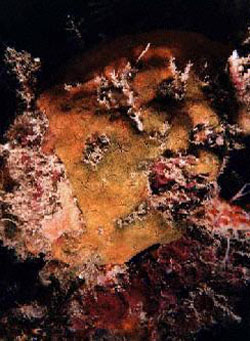|
|
Short introduction on Astrosclera willeyana
|
|
|
from WÖRHEIDE et al. (1997): Basal skeletal formation, role and preservation of
intracrystalline organic matrices, and isotopic record in the coralline sponge
Astrosclera willeyana LISTER 1900
|
|
|
The calcified demosponge Astrosclera willeyana
LISTER is a "living fossil", a Recent representative of Late Palaeozoic stromatoporoid sponges
with a rigid carbonate skeleton constructed of intracellular formed aragonitic spherulites. Modern
habitats of this sponge are restricted to dim light and dark shallow water caves and overhangs of the
Red Sea, Indo-Pacific, and Pacific coral reefs.
|
|
|
Astrosclera willeyana has a pyriform to
half-spherical habitus and a stromatoporoid organisation of the soft tissue and basal skeleton.
This coralline sponge was widely used to understand the stromatoporoid animal and a lot of papers dealt
with this topic (STEARN 1972, 1975, 1977, 1984, STEARN & PICKETT 1994, REITNER 1987, 1992). Main
problems of the proposed relationship with Palaeozoic stromatoporoids are the detailed structure of the
basal skeleton (e.g. aragonitic spherulites) and the lack of true horizontal laminae. A better
understanding of the stromatoporoid animal is given in the endemic taxon Calcifibrospongia from the
Bahamas which exhibits more similarities to fossil stromatoporoid sponges (HARTMAN 1979,
REITNER 1987, 1992).
|
|
|
Astrosclera is part of the coralline sponge
community of Indopacific reef-caves as described by REITNER (1989). The sponge lives in small crevices
and caves of the reef front and lagoon habitats in depth of 4-183 m (AYLING 1982). Mean size of the
specimens is 1-2 cm. According to our observations at Ribbon Reef No. 10 (Great Barrier Reef, GBR),
Astrosclera grows up to about 25 cm in diameter. It has a
stromatoporoid soft tissue organisation, and a three-dimensional, well-developed exhalant system
(astrorhize system).
|
|
|
 |
|
The image shows a large specimen (15cm diameter) from Ribbon Reef #10 (Great Barrier Reef)
|
|
|
|
|
|
The soft tissue covers the ontogenetic younger parts of the aragonitic skeleton. The
rest of the basal skeleton is free of soft tissue (REITNER 1987, 1989, 1992). The primary spicular
skeleton consists of acanthostyle megascleres (see below), microscleres are absent (LISTER 1900,
VACELET 1981, AYLING 1982). The secondary basal skeleton is made of aragonitic spherulites which were
formed intracellular in the very early stages. At an advanced stage the spherulites fuse together by
epitactic growth to form the rigid calcareous skeleton.
|
|
|
Astrosclera willeyana was first described from the
Loyalty- and Tuvalu Islands by LISTER (1900). He did the first work on the histology of the soft tissue
and the structure of the basal skeleton. Since then A. willeyana
has been discovered at Christmas Island (KIRKPATRICK 1910), off Madagascar (VACELET & VASSEUR 1965,
1971, VACELET et al. 1976), at LŽIle Europa (VACELET 1967), in French Polynesia ( VACELET 1977), New
Caledonia (VACELET 1981), the Great Barrier Reef (AYLING 1982) and at the Enetewak Atoll (BASILE et al.
1984). It has been observed recently by WÖRHEIDE & REITNER (unpublished data) at Cebu Island
(Philippines), Satonda Island (Sumbawa, Indonesia), the Great Astrolabe Reef (Fiji), the Osprey Reef
(Queensland Plateau, Australia), and in the northern Red Sea (Gulf of Aqaba). Fossil Astrosclera-like
sponges were described from the Cipit-boulders of the Cassian-Beds (Lower Carnian, Dolomites, Italy), the
Zlambach-Beds of Rossmoos (Rhaetian, Austria), from the upper Triassic Alakir Clay (Lycian Taurus) near
Antalya (Turkey) (CUIF 1972, GAUTRET 1986), and from the Cenomanian of Liencres (Northern Spain)
(REITNER 1989, 1992).
|
|
|
